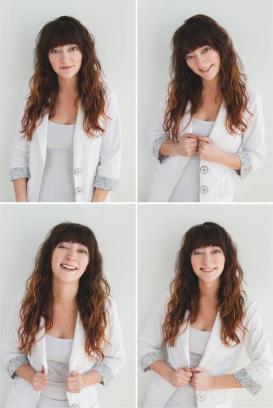by

 When I read Facebook boudoir group posts, I often see photographers puzzled about how to get more real client work on their websites. I used to be that person, until the end of last year when I completely changed how I ask clients to use their photos. It comes down to planting the seed, using the right words, putting her in control, and assuming that you will be able to use some photos from every client boudoir shoot.
When I read Facebook boudoir group posts, I often see photographers puzzled about how to get more real client work on their websites. I used to be that person, until the end of last year when I completely changed how I ask clients to use their photos. It comes down to planting the seed, using the right words, putting her in control, and assuming that you will be able to use some photos from every client boudoir shoot.
Plant the seed
When my client is starting hair and makeup, my makeup artist asks if we can do a before photo. Most clients say yes. I tell them at that point that I have every client sign a permission slip that tells me whether I have permission to show some or all of their photos in my portfolio at their ordering appointment.
Use the right words
I used to call this a Model Release, and the first paragraph included the words “allow to use.” Now, if I just paid beaucoup bucks for a photo session, and I am asked to allow my photographer to use my photos to market her services, I might feel a little uncomfortable. Then I changed the name of my form to be Permission to Show Photos, and the first paragraph says, “give permission to show photos in my portfolio.” All of a sudden the number of clients giving me the OK to show at least some of the photos jumped through the roof. Note the words:
- Permission (not allow)
- Show (not use)
- Portfolio (not marketing)
Assume you’ll get a yes
I used to assume I would not get permission to show any clients’ photos in my portfolio. And, of course, that’s what happened. My form reflected it. I had too many choices:
- No photos
- Only in studio samples
- Studio samples and online
- Only anonymous photos
- All photos
This is the order I presented the options. So, guess what response I received most? No photos. I decided to experiment with that list, and I wound up here:
- All photos
- All photos except the ones marked out on the attached contact sheet
- No photos
By giving two positive responses, I now have a 66 percent chance of getting a yes. 

Put her in charge
When I was assuming I’d get a no, I just had clients sign a form. Then, I decided to select about a dozen images, print them in a contact sheet and ask for a release on those photos. Usually, they were anonymous. The problem I ran into was clients were releasing the exact same photos. So, I never updated my boudoir portfolio. Who wants different women in the same 5 poses on their websites?
Then, I decided to print out a contact sheet showing every single photo I presented in her gallery—somewhere between 45 and 60 images. I reminded her that I ask every client to note whether I have permission to use their photos. I gave her the three choices: All, these or none. I instructed her to go through the contact sheet and mark out any photos she would not like me to show.
And then I left the room to go print her sales receipt. That alone increased my percentage of clients giving permission to about half. Then, I changed the wording and title on the form and the permission to use some, if not all, photos skyrocketed.
Give her an out
The last thing I tell a client before I leave the room is that I absolutely understand that these are private, intimate photos, and that she is under no obligation to allow me to show any of them. I assure her that I will never identify her by name (I use Ms. First Initial). Then I tell her that she may revoke her permission at any time for any or all photos by simply emailing me. I do add the caveat that once something is online, I can take it off my site but that’s as far as I can go, and if I’ve used her photos in a studio sample I’ll phase it out as soon as possible.
When I come back to her, it’s likely that she’s given permission to allow me to use many if not all of her images. Now, my problem is sorting through and again, actually updating my portfolio and blogging those images.
Ask every client
I used to pick and choose which clients I asked. When I started asking everyone, of course the number of yeses I received went up, as it’s a matter of numbers. But I was most surprised by the types of clients who were saying yes.
Making this part of my standard client workflow also took all the fear out of asking. It’s just something I do. That’s my attitude when I ask.
Thank her
When I get permission to show one or all images, I thank her in person. I thank her in a Facebook post if I make one. I thank her in the blog post (while reiterating that I only show photos if I have the client’s permission.) A little thank you goes a long way. How do you ask clients for permission to include their photos in your portfolio? What has worked? What has failed? Let us know in the comments. 



